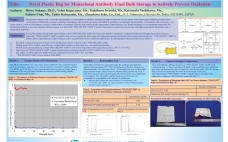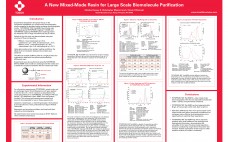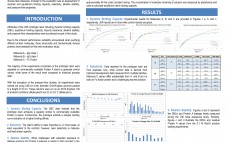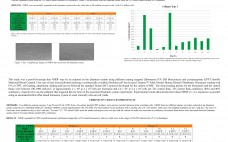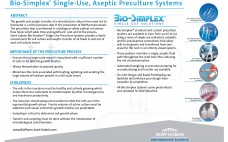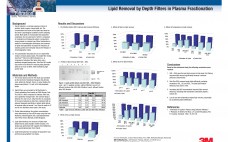Essentially, human protein such as monoclonal antibody is quite susceptible against oxidation. Nevertheless using the oxygen barrier containers, oxygen within the protein solution and oxygen leaking through the closure port of container affect to the protein. To minimize oxidation of monoclonal antibody, novel plastic bag for monoclonal antibody final bulk storage has been developed. The concept “Active” means that removing oxygen not only passively from the circumstances through the barrier layer within the container (or bag), but also actively removing…
2013 Collection
New Core Bead Chromatography Medium Enables Group Separation and High Productivity Purification of Large Molecules
When large biomolecules such as IgM or influenza virus are purified, group separation with gel filtration is the most commonly used technique. Advantages of using gel filtration include the high purity and the high recoveries that can be achieved, while a drawback is the relatively low productivity. Captoâ„¢ Core 700 is a chromatography medium (resin) from GE Healthcare Life Sciences designed with core bead technology. The core bead technology enables double functionality for Capto Core 700 – size exclusion and…
A New Mixed-Mode Resin for Large Scale Biomolecule Purification
Chromatographic resins with high capacities and selectivities differing from those seen with traditional hydrophobic interaction and ion exchange media are now in demand. Mixed-mode chromatography media is an alternative. Some mixed-mode resins combine both traditional hydrophobic interaction and ion exchange media. This poster introduces TOYOPEARL® MX-Trp-650M, a high-capacity weak cation mixed-mode resin for the purification of biomolecules. The polymethacrylic base bead was chemically modified with the amino acid tryptophan which combines a weak cationic group with a hydrophobic functional group.…
Improving Cell Culture Productivity with a SEGFLOW® Automated On-line Sampling and Feed System
A SEGFLOW® automated on-line sampling and feed system (SEGFLOW) was evaluated for its impact on Chinese Hamster Ovary (CHO) cell culture process performance in bench-scale stirred tank bioreactors. The SEGFLOW was integrated with a YSI® Biochemistry Analyzer and a nutrient feed pump allowing real-time glucose analysis and automated glucose feeding to be performed for the test batch. In contrast, a batch using daily manual sampling and bolus feed protocols, was performed as a control. For the SEGFLOW culture, media glucose…
Evaluation of a Novel Polymer Based Protein A Resin for the Capture of Immunoglobulins and Fc-Fusion Proteins
In the biopharmaceutical industry ever increasing monoclonal antibody titers in cell culture have necessitated discovery of more efficient Protein A capture operations, realized in terms of higher binding capacity, faster throughput, increased resin lifetime, and decreased cost of goods. Recent changes in the Protein A intellectual property landscape have invited new competitors to enter this market. Given the increased availability of new Protein A technology, Biogen Idec has evaluated a prototype resin being developed by JSR Life Sciences known as…
EtoxiClear™: A New Adsorbent for the Efficient Removal of Endotoxin From Biopharmaceuticals
Endotoxin or lipopolysaccharides (LPS) are highly toxic components of the cell wall of Gram-negative bacteria and are often present in significant amounts in bacterial cell culture expression systems such as E. coli. A number of methods have been adopted for the removal of endotoxin based on adsorption, in particular ion-exchange chromatography. Although downstream processing can significantly reduce endotoxin levels in the product, efficient and cost-effective removal of residual endotoxin from biopharmaceutical preparations remains a challenge. This technical poster addresses the…
Culture of Normal Human Dermal Fibroblast Cells in a Functionally Closed Automated Cell Expansion System
The Quantum Cell Expansion System is a functionally closed and automated hollow-fiber bioreactor system that is designed to expand both adherent and suspension cells in a reproducible manner. The hollow-fiber membrane requires a coating agent to help facilitate cellular adherence when culturing an adherent cell type such as MSCs. Pooled human cryoprecipitate (CPPT, Bonfils Blood Center) was examined as an alternative to FN because it is a rich source of extracellular matrix components, including fibrinogen (Freedman, 2010), and also because…
Comparison of Commercial Kits for Extraction of Residual Host Cell DNA
Expression of therapeutic proteins in cultured cells is a cost effective method for production of commercial quantities of a drug substance. However, the manufacturing and purification process of these products leaves the potential for DNA contamination from the host cells. Due to the theoretical potential for the transfer of oncogenes from the host cell, the WHO has set a residual host cell DNA limit of 10ng/dose in biologic therapeutics. Regulatory agencies have set allowable limits between 100pg/dose and 10ng/dose depending…
Bio-Simplex™ Single-Use, Aseptic PreCulture Systems
The growth and aseptic transfer of a microbial pre-culture from seed vial to bioreactor is a critical process step in the production of BioPharmaceuticals. The pre-culture step is performed in a biological safety cabinet or laminar flow hood, which adds time and significant cost and to the process. Saint-Gobain Bio-Simplexâ„¢ Single-Use Pre-culture Systems provide a sterile environment for cell culture and aseptic transfer of all fluids in and out of each cell culture vessel.
Lipid Removal by Depth Filters in Plasma Fractionation
We herein describe a 3M Purification Inc. depth filter media – Zeta PlusTM DELI that exhibits selective adsorptive properties for plasma lipids. Lipids plug chromatographic columns and filters during plasma fractionation steps and cause solution instability for the final product. Several parameters which could affect the lipid removal efficiency on Zeta Plus DELI have been investigated: prefiltration, contact time, ionic strength, pH, and temperature. The maximum percentage of total lipids eliminated, in optimal operating conditions, was 68%. This method has…

